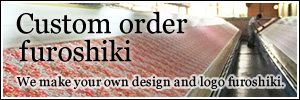Slide Shows
We deal traditional Japanese souvenirs like "tenugui" hand towels, "furoshiki" wrapping cloth, "noren" door curtains, and sensu holding fans. We also custom-print your design on these items for your company.
Japan Cultural Scenes
We feature the daily living cultures of Japan. You may find the cultural difference or may find even the similarity with yours. We hope you will enjoy these articles.
- #1 : Shotengai Shopping
- #2 : Food samples
- #3 : Onsen
- #4 : Beverage Jidou-hanbai-ki (vending machine)
- #5 : Dropping in Geisen (game center)
- #6 : Wasting money at Pachinko (Ping ball parlor)
- #7 : Looking for good Ramen restaurants
- #8 : Shopping at DEPACHIKA
- #9 : Crossing over Hodou-kyo (pedestrian overpass)
- #10 : Dropping by Konbini shop
- #11 : Kanban (Advertisement boards) wars
- #12 : Eating noodles at Tachigui-soba
- #13 : Having Bentou lunch box
- #14 : Business talking at Kissa-ten
- #15 : Senbei (rice cracker) stores disappearing
- #16 : Ekiben lunch box on train
- #17 : Advertisements in a train car
- #18 : Automated order taking at a Kaiten-Sushi (Sushi-shop)
#1 : Shotengai Shopping
Shotengai means a shopping street usually located around a railway station. You will find Shotengai nearby every railway station in major cities. Not only the commuters who use the railway station but also the residents shop daily at Shotengai. Shotengai welcomes all visitors. Some large Shotengai have arcades to protect shoppers from sunshine and rain. Some Shotengai is 1,000 meters long. The longest Shotengai in Tokyo is "Togoshi-Ginza Shotengai" (in Shinagawa-ku) and it is 1.6km long. The longest Shotengai in Japan is "Tenjin-bashi-suji Shotengai" in Osaka, and it is 2.6km long with 600 stores. Many Shotengai unions give suffix name "Ginza" to the street, because Ginza is one of the best shopping districts in Japan.
There are many shops on the both sides of a Shotengai. By visiting Shotengai, you can be almost fulfilled with your daily living needs - there are food, vegetable, confectionery, glossary, medicine, coffee, hamburger shops, and so on. You will also find banks and doctors along a Shotengai. Shotengai is something like a downtown.
Although there are many supermarkets and large discount stores in a city, many Shotengai are still surviving especially in large cities. This is because commuters shop with Shotengai after they get at a railway station on their way back home. There are 80 million automobiles in Japan, but still huge amount of people use railway service in daily life, and they often shop around railway stations.
Also, many housewives of higher ages do not drive (or don't even hold a driver's license), so it is very convenient for them to shop around the Shotengai which is a vicinity to their homes.
#2 : Food samples
Displaying food samples (made from wax) in front of a restaurant is quite popular in Japan. Whether the restaurant serves Italian, Chinese or Japanese cuisine, or whether it is a fancy or fast food shop, they display food samples for helping customers select the menu. Japanese people don't care about how the food is cooked, instead they pay more attention on how the food is served and looks like. By looking at the sample, they instantly know how the food tastes like! What is interesting is that most restaurants even display samples of beer and coke.
There are some companies specializing in making food samples in Japan. Food samples are custom-made, because the final cooked image is different for each restaurant. For example, the spaghetti Neapolitan is different in color, size and topping in each restaurant. Food sample companies make up the samples by looking at photos provided by a restaurant.
In these days, some tourists especially from western countries bring back food samples for souvenirs. Kappa-bashi street in Tokyo (nearby Ueno) is one of the most convenient places for purchasing souvenir food samples.
#3 : Onsen
Bathing at onsen (a hot spa) is a popular leisure in Japan for hundreds of years. On weekend and on holidays, many people visit onsen for making themselves comfortable. People in Japan loves bathing and it is Japanese custom to take a bath every day.
There are tremendous number of onsen, and you can find travel guidebooks specializing in onsen. One of the most famous onsen may be Kusatsu-onsen in Gunma prefecture where you can enjoy bathing in very large bathtubs of many different types (some bathtubs are placed outside). You can find many onsen especially in Gunma, Tochigi and Nagano prefectures - in other words, there are many volcanic mountains in these areas.
At most of onsen hotels (called "Ryokan"), an outside bathtub (called "Roten-buro") is provided because it is the very important factor for customers' selection of hotels. Japanese people are very fond of bathing outside! At an onsen, of course, the bathing is separated by men and women. You have to take off all of your clothing and no swimming gear is allowed. Shampoo, soap and shower are provided at onsen hotels.
#4 : Beverage Jidou-hanbai-ki (vending machine)
You will encounter beverage vending machines everywhere in Japan. They are placed not only on city streets and at public spaces, but also in residential areas, rural towns and in office buildings. Vending machine are scattered around Japan!
You can select a wide variety of drinks - carbonated drinks, Cokes, mineral water, coffee and tea. But not alcohol because it is prohibited by law for youngsters under 20 years of age to drink alcohol. Some vending machines sell cigarettes but you need a special card for an adult-checking before getting a vending machine work. Most of the drinks are sold at between 100 Yen to 150 Yen. Japanese people always like to drink beverage to refresh themselves, and maybe, this custom is derived from drinking green tea habbits in old times.
There are very few criminals of breaking out vending machines in Japan, so the number of machines is growing. However, some people have been criticizing that the vending machines consumes lots of electricity and that they also spoil city beauties.
#5 : Dropping in Geisen (game center)
So called Geisen (game arcade) can be found near by major railway stations in Japan and it is the amusement venue where you can play video games like shooting games and dancing games. Some students drop in Geisen after school, and young people visit there to have fun. However youngsters under the age of 18 are prohibited to get into Geisen after 10pm in Tokyo.
The name of Geisen is a shortened word of "Japanese English" of a game center. Japanese people are fond of playing games. The video games first got popular in 1970's, and they have been evolving along with the technology developments. Also the contents of video games are always enhanced to attract visitors.
#6 : Wasting money at Pachinko (Ping ball parlor)
There are many Pachinko parlors in Japan and many men and some wemen go there for leisure. Pachinko is the sole casino (kind of) that is allowed in Japan. Pachinko is usually located at vicinity of railways stations and in down towns.
According to Wikipedia, there were exceeding 10,000 Pachinko parlors in Japan and some 17 million people enjoyed this leisure, which created 20 trillion yen (250 billion dollars) market in 2010. However, the Pachinko market is shrinking year by year due to its bad image and also due to the diversity of leisure. Some people criticize that some Pachinko money is illegally transferred to North Korea and that most of the owners of Pachinko parlors are from North Korea. The Pachinko also causes some social issues such as pathological gambling and spoiling city scenery. There was a tragic news in the past that a mother went to a Pachinko by leaving her infant kid in her car at the parking lot, and that her kid died due to a very high temperature inside the car caused by strong summer sunshine.
#7 : Looking for good Ramen restaurants
Ramen is one of the most popular cuisines in Japan. Ramen is a bowl of noodle dipped in a meat & vegetable broth soup, and it is served with various topping such as slices of roast pokes, boiled egg, seaweed, welsh onion. There are variety of Ramen from many regions of Japan - such as Sapporo Ramen, Asahikawa Ramen (both from Hokkaido), Kitakata Ramen (from Fukushima Prefecture), Tokyo Ramen, Wakayama Ramen, Hakata Ramen, Kumamoto Ramen (from Kyushu). In eastern and northern parts of Japan, the Ramen soup is either soy source based or miso flavored, and in the western parts the Ramen soup is pork ribs broth based. At some Ramen restaurants, you may choose your preference of soup of either "Kotteri" (fatty) or "Assarti" (light). The Ramen price is usually between 500Yen to 1,200Yen, depending on the soup quality and the topping.
There are some "Ramen raters" who judge various Ramen restaurants, and they sometimes write books of Ramen restaurants with their ratings and comments.
Someimes, you will see lots of people getting in a line just to eat simple Ramen bowl at a local Ramen shop (especially at lunchtime). What is strange is that the owner will never increase the seating capacity nor open up a new shop at another location. The owner looks like not wanting an investment, but he just wants to keep his shop's reputation by showing off the long line! Is this a correct choice?
#8 : Shopping at DEPACHIKA
At the basement floor of department stores in Japan, there is a shopping complex of food, meat, fish, vegetable and confectionery. This basement floor is called "DEPACHIKA", which is the combination words of DEPA (department store) and CHIKA (basement). Depachika is always full of visitors (almost house wives) all through the day. Depachika is usually open from 10am to 8pm. Although the prices at Depachika are more expensive than those at supermarkets, Depachika foods are popular from their high qualities.
Japanese department stores are close to large railway stations. Since railways are the major traveling method in urban areas of Japan, the department stores are located nearby railways terminals for business prosperity. The department stores try to offer one-stop shopping service for living items, wearing items and foods. Many people visit a department store just to look for high quality foods at Depachika.
#9 : Crossing over Hodou-kyo (pedestrian overpass)
Hodou-kyo is a pedestrians' bridge over a busy road. There are many hodou-kyo built over major roads in urban areas. The traffic in Japan is so heavy that the government has been building these overpasses for the past 50 years to prevent automobile accidents with humans. The first pedestrian overpass was built in 1959 in Aichi Prefecture to prevent school kids from accidents with increasing automobiles. There are 80 million automobiles in these small islands of Japan, whose total square miles are smaller than that of the state of California! We always have to watch out the cars to keep ourselves safe! Jaywalking across a major road is quite dangerous!
#10 : Dropping by Konbini shop
Konbini is the Japanese-English abbreviation of convenience store. Japanese konbini are open for 24 hours and you can find them here and there. They sell foods, lunch boxes (Bentou), tv dinners, sweets, beverage, cigarettes and sometimes alcohol. They also sell stationery and magazines. An ATM, fax and copy machines are placed at Konbini. Konbini is a kind of mini-supermarket widely utilized by Japanese people. The total sales of convenience stores make up 100 billion Yen market.
Students drop by Konbini to buy beverage and sweet rolls after school, young people drop by to buy magazines and tv dinners, salaried workers buy lunch boxes, and housewives buy foods and vegetables.
Generally speaking, Japanese people buy items in a small quantity, and Konbini is a convenience place to shop when people feel necessity. In old days when there were no refrigerators, people bought what they needed for the day. This might be the cultural origin of buying in a small quantity.
Now Konbini culture is spreading over to Asian nations, and you will find convenience stores such as "Family Marts", "Seven-Eleven", "Lawsons" and "K marts" - they are Japanese origins.
#11 : Kanban (Advertisement boards) wars
Japanese cities are full of Kanban (advertisement boards) which are not so beautiful. These chaotic Kanban are spoiling city beauties. Selling and buying activities are so huge in Japan that there is little regulation that protects city scenery from Kanban. How about in your country?
In Japan, people do not pay much attention on consistent beauty of a city and town. In spite of the cleanness of each building and street, the overall look of a city is not so beautiful nor consistent. This kind of Japanese mentality may be derived from the complex landscape of Japan in which farmers needed to increase productivity in a small field.
#12 : Eating noodles at Tachigui-Soba
Tachigui-Soba is a fast food shop that serves Japanese noodle (soba or udon) bowls. "Tachi" means standing, "Gui" means eating and "Soba" means noodles. As the words mean, customers eat standing up at a counter and no seats are provided at the shop. (However, some shops are starting to equip seats to offer more comfort.) At most of Tachigui-Soba, customers need to buy tickets at the vending machine inside the shop prior to placing an order. One ticket for one menu. A noodle will be served soon after giving the ticket to a cook. It's very easy and fast! Inside the shop, chopsticks and Japanese spices called Hichimi are provided. The price of a noodle bowl is from 300 Yen (noodle with soup only called "kakesoba") to 700 Yen (with nice toppings).
You can find a tachigui-soba around a railway station and also on a platform of the station. Train passengers drop by this fast food shop to save time. Especially, hasty businessmen and easy-going young people like tachigui-soba.
Tachigui-Soba traces its history back to the Edo period in the 17th - 19th centuries. In those days, there were many food stands on streets selling Sushi, noodles, fruits, etc. People at that time were also busy and they loved to have meals at those fast food stands for saving time. Nothing much changed for 400 years...
#13 : Having Bentou lunch box
A benou is a lunch box. Everything is cooked and ready to eat - cooked fish, chicken, meats are packed with rice in a bentou. Bentou is sold at supermarket and at convenience store. There are many variety of bentou boxes - sushi, sandwiches, beef bowl, etc, and the prices are from 500 Yen to 1,200 Yen depending upon the size and contents.
Bentou shops are found at large railway stations, because many people like to bring bentou boxes into long-running trains (express trains like Shinkansen bullet trains) to save time and also to enjoy eating them on trains. Moreover, some people like drinking alcohol on express trains! The bentou boxes sold at a railway station are called Ekiben (station bentou). There are so many kinds of Ekiben in Japan, and some department stores often hold events of Ekiben collection.
#14 : Business talking at Kissa-ten
Kissa-ten is a cafe utilised for a business talk. Many businessmen talk about business by having coffee and tea. Kissa means to have tea and Ten means a store. You can find Kissa-ten almost everywhere in Japan, especially around railway stations where many people gather. Kissa-ten is a convenient and economical venue to meet collegues and customers.
Kissa-ten usually serves sandwich, spaghetti, pizza toast, cakes, parfait besides coffee and tea. At morning, Kissa-ten servers "Morning set" which is a breakfast menu with coffee and small sandwich (about 400-500 Yen) and at lunch "Lunch set" is served (about 700-900 Yen). "Lunch sets" have more variety like spaghetti, pilaf, curry rice, sandwiches. However, we rarely see "Evening set" because Kissa-ten is not a common place for businessmen to have dinner and talk. At night, Japanese busineemen go to Izakaya (a bar).
#15 : Senbei (rice cracker) stores disappearing
Senbei is a traditional baked rice cracker loved by many Japanese people. Senbei is a little bit hard to bite, so infants and old aged people with artificial teeth cannot bite them. The shape of a senbei is typically round and flat less than one centimeter thick. People often eat senbei with Japanese green tea for refreshment.
There is a saying (joke) that makes fun of abundance of time of housewives or old aged persons - they eat senbei watching TV soap operas.
There used to be many senbei stores (just selling senbei), but nowadays they are gradually disappearing. Maybe, you can find only one senbei store in a town. People buy senbei more at supermarkets because they are cheaper. As you see price tags in the picture below, a piece is sold at around 80 Yen. Each piece is wrapped by a small plastic bag.
Senbei is backed after being dipped in soy source. You can enjoy varieties of Senbei - beans mixed, sugar sprinkled, seaweed wrapped, sesame mixed, round ones, square ones, thick ones, and thin ones.
#16 : Ekiben lunch box on train
Many people in Japan enjoy having boxed lunch called "Ekiben" on trains. Rice and cooked meats, fishes, vegetables are boxed in an Ekien. You can get an Ekiben at a kiosk on a railway station and the price is around 1,000 YEN. On Japanese trains, meals are not served even on the first class seats (called "Green Car"). In these days, very few trains connect buffet cars because the trains speed up and the ride time gets shortened. So, people bring in their own lunch.
The first Ekiben in Japan appeared in 1885. The first Ekiben sold at Utsunomiya railway station at the that time was only two rice balls. Nowadays, the repertory of Ekiben has grown bigger and there are more than 1,000 Ekiben all over Japan.
#17 : Advertisements in a train car
There are many advertisements hanging from the roof of a train, and also attached to the wall of a train. These advertisements are updated every week. Commuters might not gaze at these advertisements so much, but the advertising cost on trains is fairly expensive. You have to pay at least 1 Million JPY (approx. 10,000 USD) to a train company in Tokyo on a single day basis if you wish to display your product's advertisement on train cars. However, advertising sponsors reckon that the ads on trains are very powerful, because the trains carry millions of millions of people every day.
For a train company, the train ads is another source of income. The train companies have stable source of income both from commuters and sponsors, that's why the train companies are able to invest on train cars renewal and on expanding railways. Japanese train railways are getting more and more like "spaghetti".
#18 : Automated order taking at a Kaiten-Sushi
At some Sushi shops in Japan, an ordering process is computerized. You use a front touch panel to see the menu, to order, and to display your ordering record. Your order will arrive by the belt conveyor in front of you, and amazingly the Sushi plate exactly stops at just front of you, not in front of a person sitting next to you! Sushi cooking is sometimes half-automated with a robot in the back kitchen.
In Japan, people love "automation". This is not because of cost cutting reason, but because the people are just interested in automation. The Japanese automation sprits are derived from "Karakuri" puppets creations in Edo period in the 17th-19th centuries. The "Karakuri" were moving puppets such as carrying a tea cup to a master, and playing an archery game. Japanese people tend to make automated machineries and products just because they are able to make them. The Japanese people often do not hold clear ecnomic goals for inventing automated machineries.



















